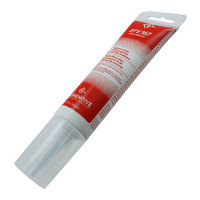RTV167-85ML MG Chemicals, RTV167-85ML Datasheet - Page 5

RTV167-85ML
Manufacturer Part Number
RTV167-85ML
Description
ADHESIVE SEALANT SIL HI STRENGTH
Manufacturer
MG Chemicals
Series
RTVr
Type
Potting Compound, 1 Partr
Specifications of RTV167-85ML
Features
High Strength
Product
Silicones
Size
2.8 oz
Application
Excellent in areas that require an extra strength sealing and bonding
Chemical Component
Silicone
Color
Grey
Dielectric Strength
19.7 KV⁄mm
Dispensing Method
Tube
Elongation
600%
Hardness
37 (Shore A)
Primary Type
Adhesive
Special Features
High Tensile Strength
Specific Gravity
1.12
Standards
UL Recognized
Temperature Range
-60 to +205 °C
Temperature, Rating
-60 to +205 °C
Tensile Strength
5.49 MPa
Thermal Conductivity
0.21 W⁄m.°K
Time, Cure
2 Days
Time, Setting
4 hrs.
Viscosity
180 g⁄Minute
Volume Resistivity
3 x 10^15 Ohm.cm
Weight
2.8 Oz.
Main Industry
Electronics
For Use With/related Products
Non Corrosive
Lead Free Status / RoHS Status
Lead free / RoHS Compliant
10. STABILITY AND REACTIVITY
STABILITY
HAZARDOUS POLYMERIZATION
HAZARDOUS THERMAL DECOMPOSITION / COMBUSTION PRODUCTS
INCOMPATIBILITY (MATERIALS TO AVOID)
CONDITIONS TO AVOID
11. TOXICOLOGICAL INFORMATION
ACUTE ORAL
ACUTE DERMAL
ACUTE INHALATION
OTHER
RTV167 3TG-Tube (0.198LBS-0.090KG)
POLYDIMETHYLSILOXANE SEALANT
Stable
Will not occur
Carbon dioxide (CO2); Carbon monoxide; Methanol; Silicon dioxide.; Formaldehyde; This product
contains methylpolysiloxanes which can generate formaldehyde at approximately 300 degrees
Fahrenheit (150'C) and above, in atmospheres which contain oxygen. Formaldehyde is a skin and
respiratory sensitizer, eye and throat irritant, acute toxicant, and potential cancer hazard. A MSDS for
formaldehyde is available from Momentive.
None known.
None known.
Remarks: Unknown
Remarks: Unknown
Remarks: Unknown
Octamethylcyclotetrasiloxane Ingestion: Rodents given large doses via oral gavage of
octamethylcyclotetrasiloxane (1600 mg/kg day, 14 days) developed increased liver weights relative to
unexposed control animals due to hepatocellular hyperplasia (increased number of liver cells which
appear normal) as well as hypertrophy (increased cell size). Inhalation: In inhalation studies,
laboratory rodents exposed to octamethylcyclotetrasiloxane (300 ppm five days week, 90 days)
developed increased liver weights in female animals relative to unexposed control animals. When the
exposure was stopped, liver weights returned to normal. Microscopic examination of the liver cells did
not show any evidence of pathology. Inhalation studies utililizing laboratory rabbits and guinea pigs
showed no effects on liver weights. Inhalation exposures typical of industrial usage (5-10 ppm)
showed no toxic effects in rodents. Range finding reproductive studies were conducted (whole body
inhalation, 70 days prior to mating, through mating, gestation and lactation) with
octamethylcyclotetrasiloxane (D4). Rats were exposed to 70 and 700 ppm. In the 700 ppm group,
there was a statistically significant reduction in mean litter size and in implantation sites. No D4
related clinical signs were observed in the pups and no exposure related pathological findings were
found. Interim results from a two generation reproductive study in rats exposed to 500 and 700 ppm
Page 5/8
Material Safety Data Sheet
Version: 1.2
08/28/2007







